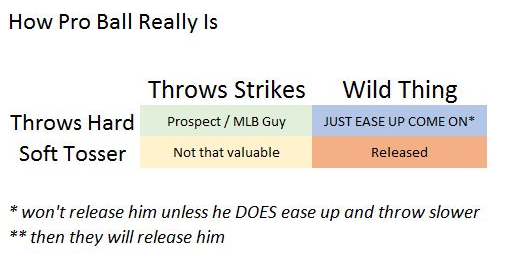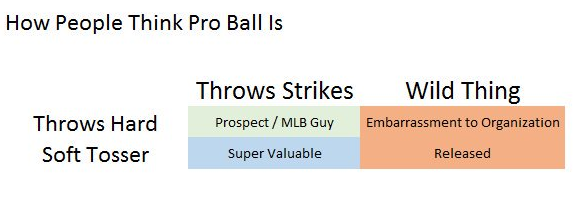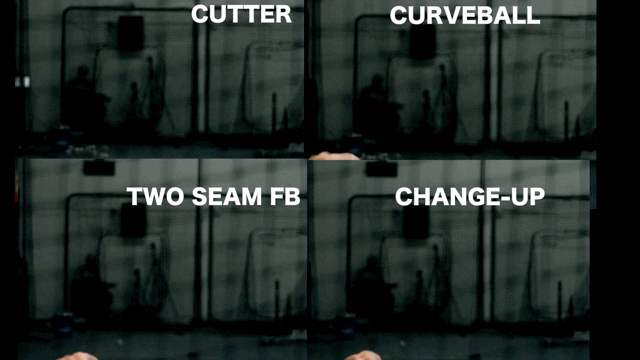Click bait title on Command

Command is often discussed in a vacuum, either you have it or you don’t. In reality any discussion on command is more complicated. We have mentioned before how difficult it is to throw strikes from a movement perspective and why problems with command are often not mental. Here we are going to look at how pitchers are judged on command and the major piece that often goes unmentioned.
So let’s dive into that, below we are going to look at how pitchers are judged on command, what we’ve seen command and velocity, statistics from the Major Leagues, and how we think of developing control of command.
It’s a lot to cover so let’s dive in.
The idea that teaching motor control and the ability to precisely command pitches is simpler skill to acquire than throwing 90+ is certainly an interesting but not uncommon belief. Maybe it’s because some still believe that velocity can’t be taught? Regardless teaching multiple athletes to have measurable improvement in command is incredibly hard.
Often overlooked when discussing a pitchers command is the role of secondary pitch quality and how that directly affects a how a pitcher’s command is judged.
Command goes beyond ‘just throwing strikes’ of all your pitches, pitch quality or the movement of each pitch is going to be vitally important.
Major League baseball provides some great data that we can look at to judge pitchers command but amateur baseball does not.
Note: For the sake of this article command is being able to throw a pitch where you want.
Pitch quality or ‘stuff’ in this article will be referencing how good a pitch is, mainly movement
Myth of the 90 MPH Ace
Velocity is your foot in the door as whatever level you want to play at. This doesn’t stop many people from arguing that you actually don’t need to throw hard and point out Greg Maddox, Kyle Hendricks, or Mark Buerhle as control specialist exceptions.

Ok so maybe only old Greg Maddox, young Greg Maddox threw hard, from @PitchingNinja
SI article on Greg Maddux from 2004 re velo/movement/control: http://t.co/QlRBBESDov pic.twitter.com/gdkFIvKfhQ
— Rob Friedman (@PitchingNinja) April 29, 2015
Yes, there are pitchers who throw 90 that have success in the big leagues but what else do they have? Above average control and movement of multiple secondary pitches.
What people often forget is they aren’t there just because of control but exceptional movement of their pitches as well.
Any ‘command specialist’ with below average velocity and pitch movement is going to get shelled, period.
So if you don’t throw 90+ you better already have multiple secondary pitches where you have above average command and movement. There are no command specialist with below average ‘stuff’ in the majors.
So velocity is actually vitally important to being promoted at any level. Many of the ‘well look at X, he doesn’t throw hard and has good control arguments’ don’t take into account that MLB’s filtering system is velocity.

Not to mention the idea that “Harder throwing pitchers have worse control” isn’t necessarily true, but it is repeated constantly.
Somehow no one looks at the high school freshman throwing 65 MPH with a 12 bb/9 and says: “See, throwing slow means you have terrible control.”
Dr. Mike Sonne looked into the relationship between velocity and control and found in MLB “Velocity results in better ERA, K/9 than control or command. Also, there’s no relationship with velocity and BB/9.”
College, Minor, and Major League Differences
Possible mechanical differences aside, not all high walk rates are directly caused by subpar command. Secondary pitch quality and movement play a role as does playing level.
What we can’t get from looking at stats is we can’t see if that fastball that was called a ball was a borderline strike that didn’t get a call, miss by 4 inches, or a miss by 8 inches. We also can’t see if a pitcher has an above average offspeed pitch that every amateur batter insists on taking.
The talent level differences combined with the way amateur ball is played changes how we compare amateur, minor leaguer, and major league pitchers. There are many reasons why it often takes so long for amateur pitchers to work there way up to the major leagues.
In the amateur level you can take two pitchers with the same command but one with way better offspeed and the pitcher with better offspeed will dominate.
In pro ball you can take two pitchers with the same command but one with way better offspeed and the pitcher with better offspeed may walk more hitters. That’s just how it works.
The pitcher with better offspeed will need to work on commanding his fastball at high intent levels and throwing offspeed anywhere over the plate for a strike.
On the flip side, the pitcher with worse offspeed needs to develop better pitches. Pitching isn’t just about striking people out, it’s about reducing exit velocity. Better offspeed pitches get both more swing and misses and softer contact.
This is where pitch development is valuable. Sometimes designing a better out pitch cuts down more walks than command work. Some pitchers are tweeners that have good enough stuff to avoid balls put in play, but not good enough to completely miss bats. Developing an average offspeed you can throw for strikes is more valuable when you have above average velocity.
If a pitcher averages 55% strikes (which is very high for any level), and a hitter works a 9-10 pitch ab by fouling off 4-5 pitches, chances are the result is a walks. He may have average to above average fastball command and below average offspeed stuff, making his ‘command’ look worse.
Let’s saw we have a pitcher with a fastball with average velocity for his level and above average command. But he has below average curveball and changeup. They are going to want to throw their curveball and changeup less, because they won’t want it to get hit. Below average offspeed pitches are going to be more likely to get taken for a ball if they are out of the strikeout, or hit for solid contact if they are in the strikezone.
This means a batter can sit fastball. So the pitcher is also going to want to nit pick his fastball at the corners making his possible average command look worse.
This problem can be solved two ways
First: Throw a faster fastball. The batter has less time to react and the pitcher has a bigger margin for error when he misses his spot.
Second: Throw a better breaking pitch. It will either get taken for a strike or result in more swings and misses in and out of the zone.
Pitchers need to realize where they are and then figure out what area’s they need to work on.
Pro Ball
Lastly, the Command Matrix above is fine for amateur ball but it changes in pro ball. This is an often held belief that pitchers with the same skill sets are just as valuable in college as the pros, that’s false.


Pitchers get drafted and promoted based on: velocity, secondary pitch quality, and command in that order.
What ever level you are at, having one above average pitch will play up always.
Lastly the difference between a pro with ‘bad’ command and an amateur with ‘good’ command is often drastic. Professional athletes have a much smaller range of misses than amateurs.
We can see the drastic difference between amateur and pro command in our gym firsthand. Or you can go on youtube and watch ex-big leaguers play in the last NBC World Series.
Lots of them haven’t pitched in a while yet still have great command. You don’t wake up one day without it. It’s a learned practice.
Percentage of Strikes and Swinging Strikes
Let’s take a look at two MLB metrics from Fangraphs: Zone % (strike zone percentage) and SwStr % (Swinging Strike percentage).
Zone % = Pitches in the strike zone / Total pitches
SwStr % = Swings and misses / Total pitches
Zone% can gives us an idea of how often a pitcher is throwing strikes, data is collected from PITCH f/x.
While SwStr% gives us an idea of the quality of a pitchers repertoire, the better a pitch the more likely they are to get a swing and miss. In this instance SwStr% is including all pitches a pitcher throws.
Below we can take a very basic look at the top 10 pitchers in both Zone% and SwStr% and some bonus notable names. This is a simplistic look but it gives us some data to reference, the qualifications were throwing 100+ innings in 2016. Remember these numbers are including all pitches.
The league average Zone% in 2016 was 47.8% while the league average SwStr% was 10.1% and there were 142 pitchers included in the sample size.
At a basic glance we can see some overlap, but closer inspection reveals some interesting names.
The league leader in Zone%, Bartolo Colon, was 57.8 % and 37 of the 142 pitchers were over 50 %. After looking at the data is seems hard to suggest that throwing strikes is the only key to being a successful pitcher, though it is a part. There just aren’t pitchers that throw 60-70 % strikes. Lastly did anyone else notice that a knuckleball pitcher, R.A. Dickey had a Zone % at 50.3%?
Comparing the two lists you can see a closer cluster of pitchers in the Swinging Strike comparison than Zone percentage.
It seems that you would want a pitcher who can throw strikes at a league average rate paired with pitches that have a high swing percentage. There is much more that can be looked at but at a basic level
End with called strike metric and link to catchers/framing and umpires
What pitchers can actually control
This video is a perfect example of how you end up making a pitcher’s command worse when a pitcher has plus velocity, plus movement, and subpar command.
Pitchers aren’t 100% in control of throwing strikes in the first place. Umpires control the strike zone and we see from the example above how umpires and framing play a role at the major league level.
Now take a minute to picture the differences between a catcher’s pitch framing abilities from college to the major leagues AND quality of umpires. So no command isn’t even entirely in the pitcher’s control.
Sometimes setting up on the black for pitcher with exceptional movement makes borderline strikes (and occasionally center strikes like this one) look like balls, making them walk more, making them look worse. Set up middle, or middle-in/middle-away and let his stuff do the work.
A college coach once said: “Develop your stuff so it’s so elite that average command plays up. Throw it through a hula hoop and screw it.”
The correct answer to how any pitcher than throws 95 MPH+ and a 2800 RPM curveball should work on their command is: throw strikes and forget fine “command” concepts.
This is why any discussion on command is directly related to the quality of pitches that a pitcher throws.
Hitters must defend velocity at all costs. You can be effective throwing at high velocity and being able to throw secondary pitch for strikes, anywhere. You don’t need to throw it low and away on the black every time but a middle/out breaking pitch is going to have to be something you will have to do.
If this was false then MLB wouldn’t be filled will guys that throw fuzz with a get-me-over secondary pitch.
The minor leagues wouldn’t be full of pitchers with either plus velocity trying to work on better offspeed. Or pitchers will subpar velocity and good offspeed trying to throw harder.
You may hear an argument against this that sounds like this: “Strikes weren’t entirely there, but he was able to get chases.”
But they still count. Hitters swing at pitches that they think look good. That is exactly the point of having a pitch with above average movement.
So the command/control argument can’t be narrowed down to simplistically to “just throw more strikes” it’s complicated by how the batter perceives the pitch coming out of the pitcher’s hand, velocity, actual command, pitch movement, and umpires.
Which a pitcher is only in control of their velocity, pitch movement, and command.
How Data Driven Training Can Help
We all want pitchers who throw hard, throw strikes, and have good secondary pitches. The best part is we now have technology available that can measure these things.
We can take a pitcher and actually measure his spin rate with Trackman and spin axis with Rapsodo and get a more complete vision of his pitches.
We can look closer at pitcher’s repertoire, judge his pitches and then look at his stats to see a more complete picture.
Does pitcher X throw hard and get by with average offspeed but average command of all of them? In that case maybe he needs to develop a better secondary pitch.
Does he have an elite offspeed pitch he should use more but he doesn’t throw because no amateur would swing at it? In this case then he needs to focus on high intent command of his his fastball and offspeed.
Our main focuses is often on velocity development, because it will always get your foot in the door. We can see command improvements from our velocity program usually driven by improve proprioception (body awareness) by throwing over and underload balls.
We can use Trackman and Rapsodo at minimum to adjust how he uses his pitches. Throw his low spin rate fastball down in the zone always, scrap the changeup at league average spin, throw the cutter with above average spin and work on developing a third pitch.
We can work with the spin rate numbers and high speed camera’s to see small differences in grip and hand position and see how they affect the pitch.

There is no reason in this day and age to continue relying on arbitrary grip and coaching tips when we have technology available that can measure what was previously unknown.
We can also work on pitches that tunnel well with one another. But first you need to ask yourself if you want your pitches to tunnel.
Jeff Long, Jonathan Judge, and Harry Pavlidis introduced Pitch Tunnel metrics on Baseball Prospectus earlier this year. We can see an example of tunneling multiple pitches below, but it’s great that we can finally start measuring tunneling to help pitchers.
(Insert Brandon Mann tunneling gif)
But the important context to this is that there is more than one way to tunnel.
You can take the route of Kyle Hendricks and want your pitches to all look the exact same. Or the Rich Hill route, where your pitches are so hard to hit that it doesn’t matter that they don’t look alike. Not everyone fits in the same box.
We can also move towards developing command with differential training. Utilizing small changes in ball weight in different control circumstances.
Casey using 4,5,6 oz balls in a flat ground session.
We can create different challenges beyond just hitting a strike zone as well.
None of this is entry level stuff, all of it is advanced work. It is also incredibly boring and mentally draining, especially when compared to velocity work.
You may think that the physical work of pitch design is less than velocity work, and that is true. But the mental fatigue is just as taxing as physical fatigue. Remember all of this needs to be earned because velocity will always be what opens the door to opportunity.
Command and Pitch Design by Age
We believe in working on velocity first followed by pitch development and command depending on age and ability.
Why this order?
Working on velocity with PlyoCare® and weighted balls can help improve command by improve proprioception. That along with working on fine differences in offspeed pitches can also improve command.
Working on command first isn’t going to transfer to velocity or movement.
Throw hard
Throw hard for strikes
Throw hard for strikes and throw offspeed
Throw hard for strikes and throw offspeed for strikes
Youth athletes (under 14/high school age): Just focus on throwing fastballs with high intent for strikes. The best youth pitchers will be able to succeed just by throwing fastballs for strikes.
The best command program for kids is: Put a target the size of a strike zone up. Let the kid throw to it at high intent. And, here’s the secret: don’t coach them just let them throw.
Fastball command plays at all levels of baseball. Teach kids to throw to spots with heaters at high intent early.
High school athletes: Worry about breaking balls and changeups after you can throw with above average fastball velocity and command. Your first two years of high school can be effective throwing hard fastballs in the zone. There is no secret. The pitchers who play varsity ball early are the harder throwers not the ones with better stuff at lower velocities. Above average fastball velocity and average offspeed can get you into the college game.
College athletes: Throw harder to get in the door of pro ball, start to refine/improve the movement of your offspeed pitches.
Pro athletes: Throw harder to get promoted and improve the movement and command of your offspeed pitches.
Pitcher’s often can get promoted because they have one above average pitch.
Comment section